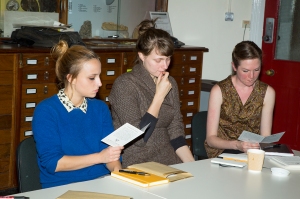RESPONSE #2 James Paz
In the most recent 100 Hours meeting we were introduced to an arcane ‘Order of the Third Bird’ whose history must remain obscure but which manifests itself in ritual performances of collective, sustained ‘attention’ to objects. The historical linguist in me wants to note that our word ‘attend’ comes from Latin attendere, literally ‘to stretch towards’ from ad- ‘to’ and tendere ‘stretch’. The etymology suggests a gesture but also an effort, a sort of exercise that strains us mentally and physically.
As such, this workshop shifted the focus from the thing itself to the way that we, as human beings, encounter it. How do we meet and greet material things? How do we interact with the environments in which things dwell? What do we do with our bodies? In what ways do we reach out with our minds? Silence, stance, movement, time, and thought processes, were all put to new and somewhat strained use as part of this ritual performance. I will not divulge the exact details of the Third Bird ritual, but the stage that stayed with me the most was that of NEGATION, whereby the viewer must ‘refuse; unmake the work and self.’ As I enacted it, I came to understand that negation does not have to entail distraction – be that looking away or imagining an elsewhere – but can involve staring or touching or thinking so intently that the object almost blurs or melts or dissolves and is thus uncreated.
I applied this lesson to my 100 Hours object: the Egyptian oracular bust. The bust was once part of a ritual or custom that I no longer have knowledge of or access to; and this is one of the many barriers between us. Could this new ritual I had been taught unlock or activate something? One of my desires is to hear the oracular bust speak. What could I do to summon up its voice? By listening long enough, and carefully enough, by breaking through that human need for speech or song or weeping or laughter, you realise that silence is its voice, a silence that amplifies those secret fears and yearnings we all hear but do not always acknowledge. And what about those other ways humans have of communicating: the smiling mouth, the wondering eyes, the laughing cheeks? Again, when you face the face of the bust for long enough, when you look so close that you forget what you’re seeing, the thing sheds its anthropoid features. The same effect occurs when I move around it, staring at it from unusual angles: recognisable lines and curves morph into indistinct yet smooth shapes asking to be held and handled; not looked at, spoken to, or listened to.
One of the tenets of the Order of the Third Bird is to avoid interpretation. To avoid interpretation was to avoid interpreting the oracular bust as a person. Despite initial appearances, I must not assume that it wants to be treated like another human being. Indeed, one of the difficulties I had with the Third Bird ritual centred on the collective attention required. The performance started off with a heightened self-consciousness and increased awkwardness around other human bodies. I felt that my commitment to the ritual was compromised by their presence. And yet, for me, human presence is the very quality that this ritual performance has reshaped.


I think your discussion of the etymology of ‘attend’ is really useful James. We need an etymology session!